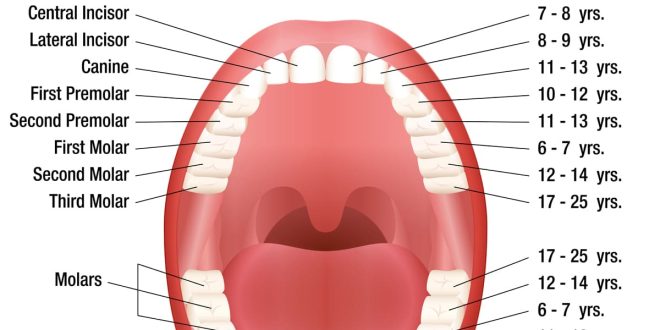Have you ever wondered what the tooth numbering system used by dentists means? It’s simpler than you might think, and knowing how the tooth numbering system works will help you understand your next dental visit that much better. Here’s what to expect when the dentist starts to talk about teeth numbers and why they are so important to your oral health care.
What Is A Dental Tooth Number Chart?
Dental tooth number chart can be very helpful for both patients and dental professionals. For patients, a tooth chart can help them identify and understand their own teeth and it can also be used to refer to when visiting a dentist. While such charts are not necessary for every patient, they may prove helpful for those who have difficulty remembering where teeth are located or have dental anxiety. For dental professionals, numbering of teeth is crucial in order to determine which specific tooth is being discussed or treated on a particular visit. Dental charts should show which teeth correspond with each number along with any other useful information that dentists may find helpful in treating certain patients.
How Are Teeth Numbered?
There are thirty-two teeth in total, including four wisdom teeth. We refer to them as we go from front to back: central incisors, lateral incisors, canines (cannons), first premolars (bicuspids), second premolars (bicuspids), first molars, second molars and third molars. [1] This system helps dentists reference teeth when it comes time for an extraction.
What Are Wisdom Teeth Numbers?
Wisdom teeth are often referred to by their numbers, but some dentists use a numbering system that’s a little different from what you might expect. For example, #4 is known as upper right third molar, and so on. That said, it’s common for patients to know their wisdom teeth by name only. If your dentist uses tooth numbers instead of names, here’s a basic guide to help you understand what each number means
What Are The Different Types Of Tooth Numbering System?
They range from a straight numbering system to your own personal tooth chart with numbers. Depending on what works best for you, will depend on which of these teeth charts you choose. There is no right or wrong answer when it comes to teeth numbering systems, so pick whatever one is most comfortable for you. Once you have chosen a teeth chart, start referring to it whenever it’s time to brush your teeth or go see your dentist!
What Are Teeth Numbers And Names?
Some people find it useful to use tooth numbers when talking about their teeth. Just like you have numbered lines on your face (1, 2, 3), your teeth are also numbered in a specific way. There are 28 teeth in your mouth and each tooth is given a number starting from one side of your mouth to another. When examining a dental tooth numbers, it may seem like an arbitrary system – why not start with zero or one instead of starting with number one?
Universal Numbering System
Tooth numbering is something that is well worth understanding. Without a good numbering system, it can be difficult to understand where teeth are located and how they fit together. Luckily, you don’t have to memorize everything about your mouth—instead, all you need to do is learn about tooth numbering. First of all, every tooth in your mouth has a number associated with it: four on top and four on bottom. However, there are additional numbers related to each one of these front teeth and back teeth as well. Although it takes some practice to get used to using numbered charts when talking about teeth, they really make everything easier in terms of dental care overall.
Palmer Notation Numbering System
Dental procedures and diagnoses are usually indicated by a two-part code, beginning with a letter indicating whether we’re talking about teeth or bones and followed by a series of numbers indicating which tooth (or bone) is being referenced. Tooth numbering starts at 1, so that top central incisor is I1; bottom left lateral incisor is L1; upper right first premolar P1. Let’s assume these are all your own teeth. So far so good. But what if you have work done to correct crowded teeth, replace missing teeth, fill cavities—which tooth number gets assigned to the new tooth or old tooth that was removed for more room for those remaining behind?
Federation Dentaire Internationale Numbering System
In English, we name our teeth based on their position (see diagram below). For example, a specific tooth may be called the front left lateral incisor. In French and in many other countries, they use numbers. For example, they might call it 1 or even just say left front tooth #1. If you want to communicate with your dentist overseas, be sure to learn how he names his teeth. Confusingly enough, there are several numbering systems that have been used over time—and may still be used today depending on where you go for treatment. Check out our post on International Tooth Naming Conventions to figure out which system is being used in your country.
Baby Teeth Eruption Chart
Though you may not realize it at first, a child’s teeth begin forming in his or her mouth while still in utero. As soon as a child is born, and even before teeth appear, many parents get their children’s teeth counted. This can be done using any number of tooth numbering systems to keep track of when and where baby teeth are breaking through for years to come. Here we discuss four common tooth numbering systems: Blank Tooth Numbering System, Numbered Tooth Chart, Teeth Names Chart, and Tooth Numbers Dental chart; each detailing where baby teeth will emerge from until they fall out permanently around age 12-13.
Permanent Teeth Eruption Chart
When we were babies, our teeth started to come in around six months. However, it was a slow process because it was about another five years before all of our 20 primary (baby) teeth would be fully in place. But how do you remember which tooth comes next when they’re all so closely packed together? Well, dentists have found an easy way for us to keep track: by using a numbering system! This chart shows exactly where each permanent tooth will come in and when its predecessor is ready to fall out! Read on for more information…
 Posting Point
Posting Point

